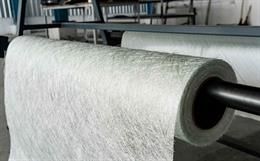For almost as long as humans have dreamt of powered flight, textiles have played a pivotal role in making these dreams real. From medieval Chinese and Japanese war kites and Leonardo da Vinci’s Renaissance-era set of wings to the Wright Brothers’ first flight, people have used fabric to enable gliding and true flight for millennia. Even Icarus and Daedalus from ancient Greek myths sewed feathers and wax onto fabric.
Sails were one of the earliest practical inspirations for textiles in flight. In many cases, improving their strength or durability would add weight. Lighter textiles were easier to work with, but required more frequent maintenance and did not stand up as well to the sea air and the bright sunlight. By far the most common sail material in antiquity was wool, and the Vikings took full advantage of its abundance. Viking longboats were lightweight and portable due to this, and their design inspired others to make similar adaptations to their vessels. As technology has moved forward, so have these innovations, and the air and space industries are relying on textiles more and more with time. When Boeing’s 787 Dreamliner aircraft debuted, the fact that it was composed of 80 per cent composite materials (mostly carbon fibre reinforced plastic) made headlines.
Two decades later, the idea is treated as the norm. Looking into the future, it is pertinent to ask: What roles will textiles play in the aerospace industry, and what textiles will humanity bring to the Moon and Mars?
Reducing Weight, Increasing Utility
As one of the strongest natural fibres in existence, hemp fabric is more durable than cotton of a similar weight, and it takes fewer minerals and nutrients from the soil. In 2021, Derek Kesek of Canadian cannabis company Hempearth took advantage of this by unveiling the world’s first fully hemp-based airplane. From the chassis to the seat cushions, hemp fibres are integral to its construction, and it is even fuelled using cannabis oil instead of fossil fuels. These composite hemp fibres are lighter and up to ten times stronger than steel, and they could easily replace fibreglass in many aerospace applications.1 In particular, Kesek’s hemp-based composite construction is showing promise in the aerospace and other industries, where it is critical to minimise the weight of items without sacrificing their strength. Particularly in the field of space flight, where every kilogram of mass can add thousands (or even tens of thousands) of dollars to the cost of a launch, developments such as these can be critical to a mission.
Companies like 3M and Honeywell in the United States have found amazing utility in their lightweight composite textiles for aerospace. Manufacturers of communications satellites increasingly rely on knitted mesh made from graphene, molybdenum or other materials to improve their signal clarity and enable the satellites to fold into a small space during launch. Thanks to their knitted construction, these textiles maximise their surface area while minimising mass, allowing for more and more complex designs and utilities. They can also be used to create strong tethers and spacesuits, and it remains to be seen what other utilities these materials will have as innovations in weaving and braiding continue.
Innovative Ways the Aerospace Industry is Using Old Technology
When NASA launched the Perseverance lander in 2020, the lander carried a suite of seven primary science instruments, including the first system to hopefully bring samples back from Mars. It also carried five samples of Earth textiles for use in space suits, as well as a piece of a helmet visor. The Scanning Habitable Environments with Raman & Luminescence for Organics & Chemicals (SHERLOC) tool is periodically scanning each of these samples, giving space agencies and private companies critical real-world experience years before people start to land on the red planet. Simply having this information about materials that have existed for years is invaluable, especially when combined with the innovative materials described in the next section of this article.
One of the most obvious ways the aerospace industry takes knowledge from the past is in methodology. Knitting and weaving have existed for millennia, and with novel materials such as carbon fibres, they have only deepened their utility. Many of the smart textiles that are utilised in the most innovative aerospace applications even rely on these structures. One of the latest innovations in smart textiles was developed primarily for aerospace. Earlier in 2023, American textile contractor Nautilus Defence and technology company Leidos Incorporated debuted their Smart Electrically Powered and Networked Textile Systems (SMART ePANTS) technology. This innovation, created alongside the United States Navy, integrates electrical power and data networks with antenna arrays in a variety of smart textiles. This project may allow acoustic protection without wires, distributed computers integrated into clothing and other forms of body-worn electronics that will be particularly useful in aerospace.
New Materials, New Uses
Fabrics have been critical components of the aerospace industry for decades. In addition to insulation and protection from the elements, these textiles can provide strength, flexibility and fire resistance all at once. Simply because the industry has relied on these for so long does not mean there are no innovations to be made, however.
Heat and flame resistance pose some of the greatest opportunities in this regard. Textiles such as DuPont’s Nomex have been staples of the industry for decades thanks to their light weight, their flexible nature and their flame resistance. However, in recent years, people have been integrating aerogels into textiles for even greater effect. Their flexibility and their thinness make aerogel fabrics prime candidates for use in spacesuits, and space agencies have been using them to these ends for decades. In addition to thermal insulation, however, textiles made with aerogels may insulate against even more. Aerogel structures are excellent at dampening vibrations, and thanks to their pore volume, they feature dynamic stiffness and a low resonance frequency. Resonant vibrations are some of the largest hazards in space flight, especially during launch and landing, and the group of mechanical engineers at the University of Texas, Dallas who discovered the vibration-isolating properties of these materials are hopeful that aerogel textiles can open new avenues in a variety of industries.
In addition to aerogels, innovative fabric coatings, new materials and improved weaving and fabrication methods are being utilised in nearly every aspect of the aerospace industry. These materials have found their way into jet engines, airframe seals, fire protection systems, insulation covers and even gaskets. Even more, the advent of 3D printing has brought a new wave of innovation to aerospace textiles. Textile firms are studying ways to integrate 3D printing into their processes to reduce waste on Earth, and these same methods will serve long-term missions to the Moon and to Mars as well.
Returning to the Moon and Moving Forward to Mars
It has been more than half a century since the last humans set foot on the Moon. Spacesuits of that day were sewn entirely by hand, by a team of seamstresses in Dover, Delaware who were hand-picked by NASA for the job. These women worked directly with NASA’s engineers to maximise their precision, and they considered their work to be a ‘one-person space craft’. Even their threads had never been used before. The aerospace and textile industries have come a huge distance since then. The space suits that NASA currently uses have gone from being custom made for each astronaut to being manufactured and stored “off the rack” in the very same facility in Dover, with modular parts that can be changed out for each user.2 As NASA plans to send people back to the Moon with the Artemis missions that were announced earlier this year, the agency has rethought its approach to space suits. Lunar dust was a major problem for the Apollo astronauts, and it will be for the Artemis ones as well. While the suits worn on current space missions do not need to account for this, the suits used for the Artemis missions are being redesigned to avoid the abrasive effect. Axiom Space’s next-gen AxEMU spacesuit is specifically designed to repel lunar dust. While the company has remained quiet on the exact nature of this dust mitigation, thanks to proprietary concerns, they have worked directly with NASA to ensure that the Artemis crews will not face the same respiratory and technical issues that the ones on the Apollo missions did.
Astronauts on any long-term space mission need to be extremely careful regarding the clothing they bring. In general, this means bringing as few items of clothing as possible and discarding items once they become unwearable or soiled. For his year on the International Space Station (ISS), former NASA astronaut Scott Kelly had to follow the same clothing rules as any visitor, with strict limitations based on the weight of the clothes and the length of his stay. Like all ISS astronauts, he did not bring these garments home, either: once they were soiled, they were disposed of in a decaying orbit, burning up in the atmosphere. For a single year, that can amount to 68 kilograms of clothing, which would quickly become untenable on a long-term mission with many people (especially when they are outside of low Earth orbit and have no place to dispose of their soiled clothing).3 United States company Procter & Gamble is addressing this solution by developing laundry detergents and washing machines for use in zero- and low-gravity applications, ideally with reclaimed wastewater. Other companies are creating antimicrobial fabrics and fabric coatings to increase the useful life of an astronaut’s clothes.
Thermal management is a critical aspect of the aerospace industry. Airplane manufacturers have been using active and passive heat exchangers in their construction for nearly as long as air travel has existed. With the advent of space travel, the need for thermal management only grew. Space agencies in the United States and the Soviet Union (erstwhile) became increasingly reliant on textiles to insulate their payloads from the extreme temperatures they would encounter as they left and re-entered Earth’s atmosphere. In the early days of the space race, and even as recently as NASA’s space shuttle, beta glass fibres reigned supreme. In the space shuttle’s thermal protection system, seven different textiles were used at different points of the orbiter based on the area’s heat protection needs. But even then, many of these tiles were highly fragile, meaning that they could not be reused over multiple missions. The thermal protection system tiles on the original space shuttle design had so little density that they could easily be crushed by hand. In modern times, space agencies have made great leaps forward in this regard.
Both spacecraft and space suits in the twenty-first century are using ultra-modern textiles for thermal management. One study in 2022 explored the use of graphene and graphene derivatives for passive and active thermal protection as well as flame retardancy on spacecraft.4 The paper also examined the utility of these materials in space suits. Graphene’s superior strength, flexibility and thermal protection qualities are going to make it integral to the aerospace industry for many years to come. In addition to these reflective and absorbent insulators, as well as phase change materials (PCMs), shape-shifting textiles have recently come into the fore for active heat management in aerospace contexts. Unlike their counterparts, shape-shifting textiles respond to their environment. They could be used in the lining of a space suit to respond when an astronaut is sweating excessively. The University of Maryland’s MetaCool textile, first revealed in Science in 2019, opens and closes its pores based on ambient temperature and humidity. In addition to its immediate utility in spacesuits, the team’s thermally responsive fabric is showing great promise for use in households. Insulation made from MetaCool may dramatically reduce the need for heating, ventilation, and air conditioning in homes and large buildings, reducing humanity’s impact on the environment here on Earth as well.
Mars, meanwhile, is a far more distant goal, in terms of both distance and time. And unlike the Moon, Mars is prone to violent windstorms that spread Martian sand and dust everywhere, adding a different level of need for environmental protection. The fact that no samples of actual Martian soil are expected to Earth before the early 2030s complicates matters even further. However, designers have utilised Martian regolith simulants to approximate the impact of this dust on landers for decades, and in recent years they have applied this technology to space suits as well. A group of researchers at Deakin University in Australia have piloted an electrospinning machine that incorporates nanofibers into haze masks, air filtration systems and other items to trap these particles. As climate change on Earth continues to intensify, these filters will most likely find utility on Earth before they ever reach the red planet. Likewise, NASA’s self-cleaning ‘Lotus Coating’ utilises a fluoropolymer matrix to increase nano-scale roughness for passive dust, ice and water mitigation. While the coating is designed primarily for hard surfaces, it can be applied to nearly anything, and in addition to its potential use in space textiles, it may even find its way into the clean rooms that are used to manufacture the capsules.
While lunar spacesuits and the ones used on the ISS are optimised for the vacuum of space, and they even use the lack of atmosphere to improve their thermal insulation, a Martian spacesuit has an atmosphere to contend with. Moreover, unlike the atmosphere on the ISS, a human habitat on Mars will likely contain up to forty per cent oxygen (compared to Earth’s twenty per cent). This will require advanced flame resistance, as well as the need for long term comfort and reusability. Designers have taken inspiration from the Australian clothing brand Draggin Jeans to incorporate Kevlar into denim, imparting them with thermal protection while remaining easy to wear.
Nearly everything that people bring to an environment like a long-term space mission has to fulfil multiple duties. For years, NASA’s Wearable Electronics Application and Research (WEAR) Laboratory and the Johnson Space Centre (JSC) have worked with a variety of designers to develop smart textiles that can track astronauts’ location and health, transmit video and audio and more. One of their latest inventions is a flexible fabric upper body exoskeleton. It is lightweight and portable, enhancing the wearer’s muscle control in their elbows and shoulders. While the exoskeleton’s designers had the long-term health of astronauts in Mars’ and the Moon’s reduced gravity in mind, these suits will most likely find utility in hospitals as well, as this technology shows great promise in the rehabilitation of people who have suffered strokes or other traumatic brain injuries.
The JSC also partners with a variety of universities around the world to enable student innovation. One of the most recent inventions through this programme came from Ally Rice, a Ph.D. student at The Ohio State University. Last year, she and her faculty advisor created a wearable fabric sleeve that uses “biomatched” antennas to monitor astronauts’ key biomarkers such as muscle tone and fluid placement. This will allow them to fine tune their physical activity and address issues such as muscle atrophy before they become severe, and it may prevent them from needing to bring bulky or heavy scanning equipment on every journey. On Earth, these sleeves may be used to track osteoporosis and even possibly detect cancer.
Another approach when it comes to a long-term mission to Mars is to allow astronauts to create the materials they need on their own. This concept is called in situ resource utilisation, and it is integral to long-term space travel. Without the ability to grow plants or raise animals on the red planet, however, space agencies had resigned themselves to the idea of sending hundreds of kilograms of Mars-suitable textiles with every mission. With the Mars Boot, people are making great attempts to change that. Industrial engineer Maurizio Montalti and footwear designer Liz Ciokajlo recently announced the Mars Boot. These boots are specifically designed for the Martian gravity, terrain and radiation levels. More importantly, the materials combine existing textiles with mycelial fungus, whose spores the astronauts can bring on their journey. The astronauts can even use their own recycled sweat in the creation process, allowing further resource optimisation.
Finally, the people who eventually go to Mars will require clothing that is well adapted to the environment, both outside of their habitat and within it. Textile and fashion designer Anurita Chandola, who is based in Lucknow (India), has created spacesuits that can double up as sleeping bags and dresses that can maintain their form in the low Martian gravity, and can even be reshaped to maximise its use. Interior padding cushions will make it easier for people to live in reduced gravity, on Mars and during the seven-month journey. In her work with the United Kingdom’s ‘Building a Martian House’ project, she has also experimented with natural dyes and dyeing processes that will reduce the waste that a Mars mission produces. Finally, she has integrated many traditional Indian prints and patterns into her line of ‘space-wear’.
Building a New Future From the Textile Industry’s Past
The world has come a long way from creating sails by hand and saturating them with oil. Fibreglass and composite textiles are the kings of transport these days, for both their weight and their strength. Every part of that chain — from war kites to early airplanes to rockets — has moved the industry forward. And every part of that chain is still linked, even today. In the end, it is just as important to keep a hold on the past as it is to move into the future. Novel environments require novel solutions, and with textiles forming the literal fabric of human society, they will be integral to these solutions. The future can only reach its true potential when industries learn from their past, and even new industries such as aerospace have a lot of past to learn from.
- https://sea.mashable.com/tech/14737/weed-company-builds-plane-thats-made-from-hemp-and-powered-by-cannabis-oil
- https://sma.nasa.gov/SignificantIncidentsEVA2018/assets/space_suit_evolution.pdf
- https://apnews.com/article/laundry-wash-clothes-space-station-nasa-5a7f2795150f7dce81581cfb82cdd1f7
- https://onlinelibrary.wiley.com/doi/abs/10.1002/adfm.202205934








